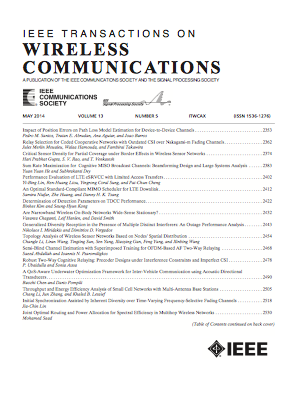Demand-Aware Beam Hopping and Power Allocation for Load Balancing in Digital Twin Empowered LEO Satellite Networks
IF 10.7
1区 计算机科学
Q1 ENGINEERING, ELECTRICAL & ELECTRONIC
引用次数: 0
Abstract
Low-Earth orbit (LEO) satellites utilizing beam hopping (BH) technology offer extensive coverage, low latency, high bandwidth, and significant flexibility. However, the uneven geographical distribution and temporal variability of ground traffic demands, combined with the high mobility of LEO satellites, present significant challenges for efficient beam resource utilization. Traditional BH methods based on GEO satellites fail to address issues such as satellite interference, overlapping coverage, and mobility. This paper explores a Digital Twin (DT)-based collaborative resource allocation network for multiple LEO satellites with overlapping coverage areas. A two-tier optimization problem, focusing on load balancing and cell service fairness, is proposed to maximize throughput and minimize inter-cell service delay. The DT layer optimizes the allocation of overlapping coverage cells by designing BH patterns for each satellite, while the LEO layer optimizes power allocation for each selected service cell. At the DT layer, an Actor-Critic network is deployed on each agent, with a global critic network in the cloud center. The A3C algorithm is employed to optimize the DT layer. Concurrently, the LEO layer optimization is performed using a Multi-Agent Reinforcement Learning algorithm, where each beam functions as an independent agent. The simulation results show that this method reduces satellite load disparity by about 72.5% and decreases the average delay to 12ms. Additionally, our approach outperforms other benchmarks in terms of throughput, ensuring a better alignment between offered and requested data.基于需求感知的低轨卫星网络波束跳变与功率分配
低地球轨道(LEO)卫星利用波束跳(BH)技术提供广泛的覆盖、低延迟、高带宽和显著的灵活性。然而,地面交通需求的不均匀地理分布和时间变化,再加上低轨道卫星的高机动性,对有效利用波束资源提出了重大挑战。传统的基于GEO卫星的BH方法无法解决卫星干扰、重叠覆盖和机动性等问题。针对覆盖区域重叠的多颗低轨道卫星,研究了一种基于数字孪生(DT)的协同资源分配网络。提出了一种以负载均衡和小区服务公平性为核心的两层优化问题,以实现吞吐量最大化和小区间服务延迟最小化。DT层通过为每颗卫星设计BH方向图来优化重叠覆盖小区的分配,而LEO层则为每个选定的业务小区优化功率分配。在DT层,在每个代理上部署一个参与者-评论家网络,在云中心部署一个全球评论家网络。采用A3C算法对DT层进行优化。同时,LEO层优化使用多智能体强化学习算法,其中每个光束作为一个独立的智能体。仿真结果表明,该方法将卫星负载差降低了约72.5%,平均时延降至12ms。此外,我们的方法在吞吐量方面优于其他基准测试,确保提供的数据和请求的数据更好地一致。
本文章由计算机程序翻译,如有差异,请以英文原文为准。
求助全文
约1分钟内获得全文
求助全文
来源期刊
CiteScore
18.60
自引率
10.60%
发文量
708
审稿时长
5.6 months
期刊介绍:
The IEEE Transactions on Wireless Communications is a prestigious publication that showcases cutting-edge advancements in wireless communications. It welcomes both theoretical and practical contributions in various areas. The scope of the Transactions encompasses a wide range of topics, including modulation and coding, detection and estimation, propagation and channel characterization, and diversity techniques. The journal also emphasizes the physical and link layer communication aspects of network architectures and protocols.
The journal is open to papers on specific topics or non-traditional topics related to specific application areas. This includes simulation tools and methodologies, orthogonal frequency division multiplexing, MIMO systems, and wireless over optical technologies.
Overall, the IEEE Transactions on Wireless Communications serves as a platform for high-quality manuscripts that push the boundaries of wireless communications and contribute to advancements in the field.

 求助内容:
求助内容: 应助结果提醒方式:
应助结果提醒方式:


